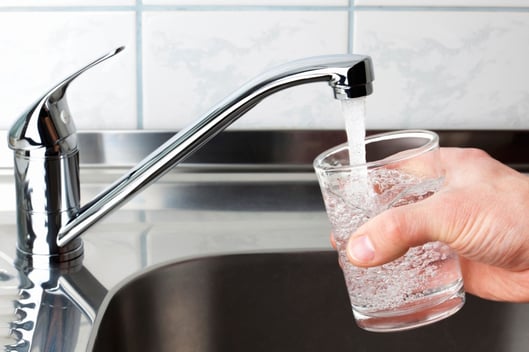HTP - Aug 11, 2015
How Clean is Your Water?
In honor of National Water Quality Month, we have gathered some information on the quality of your public water systems. The Center for Disease Control and Prevention reviewed health issues related to water quality. The CDC also explains how contaminants get into your drinking water and whether or not your water is safe to drink. --

Public Water Systems
- What type of health issues can be related to water quality?
- The presence of certain contaminants in our water can lead to health issues, including gastrointestinal illness, reproductive problems, and neurological disorders. Infants, young children, pregnant women, the elderly, and immunocompromised persons may be especially at risk for becoming ill after drinking contaminated water. For example, elevated levels of lead can cause serious health problems, especially for pregnant women and young children. Federal law requires that systems reduce certain contaminants to set levels, in order to protect human health.
- How do I know that the water in my home is safe to drink?
- The United States Environmental Protection Agency (EPA) is responsible for making sure that public water supplies within the United States are safe. In 1974, Congress passed the Safe Drinking Water Act. This law sought to protect the nation’s public drinking water supply by giving EPA authority to set the standards for drinking water quality and oversee the states, localities, and water suppliers who implement those standards. In 1986 and 1996, the law was amended to protect drinking water and its sources, which include rivers, lakes, reservoirs, springs, and ground water wells.
- How do contaminants (germs and chemicals) get into my drinking water?
- There can be many sources of contamination of our water systems. Here is a list of the most common sources of contaminants:
- Naturally occurring chemicals and minerals (for example, arsenic, radon, uranium)
- Local land use practices (fertilizers, pesticides, livestock, concentrated animal feeding operations)
- Manufacturing processes
- Sewer overflows
- Malfunctioning wastewater treatment systems (for example, nearby septic systems)
- Many contaminants that pose known human health risks are regulated by the United States Environmental Protection Agency (EPA). EPA makes sure that water meets certain standards, so you can be sure that high levels of contaminants are not in your water.
- Who do I need to contact to find out more information about water quality in my area?
-
Every community water supplier must provide an annual report, sometimes called a Consumer Confidence Report, or "CCR," to its customers. The report provides information on your local drinking water quality, including the water's source, contaminants found in the water, and how consumers can get involved in protecting drinking water.
- View the CDC's guide to Understanding Consumer Confidence Reports
- See if your CCR is posted online (United States Environmental Protection Agency Local Drinking Water Information)
- How often does our public water system test our drinking water?
- Frequency of drinking water testing depends on the number of people served, the type of water source, and types of contaminants. Certain contaminants are tested for more frequently than others, as set forth by the Safe Drinking Water Act. You can find out about levels of regulated contaminants in your treated water for the preceding calendar year in your annual Consumer Confidence Report(CCR).
- (Original Article: http://www.cdc.gov/healthywater/drinking/public/drinking-water-faq.html)
PREVIOUS POST
Share Your Installation Picture With Us!
Share Your Installation Picture With Us!
Next Post
HTP Introduces the Enduro Ti!
HTP Introduces the Enduro Ti!

